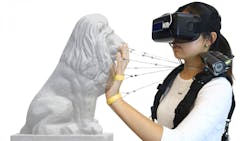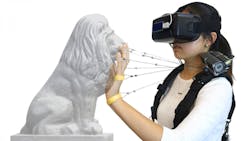Simulating the Feel of Solid Objects in Virtual Reality
Virtual reality technology remains in its infancy, but the potential uses seem boundless as new immersive experiences change the way we live, socialize and work.
One area in which VR is showing promise is haptic technology, which uses touch to control and interact with computers. In virtual environments haptics has been used in simulators, control systems and devices, and researchers are honing their understanding of tactile interaction with objects and holograms.
Carnegie Mellon University researchers developed a device that uses multiple strings attached to the hand and fingers to simulate the feel of obstacles and heavy objects.
The researchers explain that by locking the strings when the user’s hand is near a virtual wall, for instance, the device simulates the sense of touching the wall. Similarly, the string mechanism enables users to feel the contours of a virtual sculpture, sense resistance when they push on a piece of furniture or even give a high-five to a virtual character. A paper detailing these findings was published in the Association for Computing Machinery’s Digital Library
The shoulder-mounted device takes advantage of spring-loaded strings to reduce weight, consume less battery power and keep costs low, said Cathy Fang, who is on schedule to graduate from CMU next month with a joint degree in mechanical engineering and human-computer interaction.
Fang and her colleagues point out that user evaluation of the multistring device is more realistic than other haptic techniques. “Elements such as walls, furniture and virtual characters are key to building immersive virtual worlds, and yet contemporary VR systems do little more than vibrate hand controllers,” noted Chris Harrison, assistant professor in CMU’s Human-Computer Interaction Institute (HCII).
“I think the experience creates surprises, such as when you interact with a railing and can wrap your fingers around it,” Fang said. “It's also fun to explore the feel of irregular objects, such as a statue.”
The use of strings to create haptic feedback is not unique. Similar devices typically use motors to control the strings. The CMU researchers envisioned a system that would be both lightweight and affordable. But since motors consume a lot of power, the team opted to use spring-loaded retractors instead of motors. They added a ratchet mechanism that can be rapidly locked with an electrically controlled latch. Only a small amount of electrical power is needed to engage the latch, the researchers explained, so the system is energy efficient and can be operated on battery power.
A key feature of the VR headset is that it is equipped with a Leap Motion sensor for tracking hand and finger motions. The researchers said that when it senses a user’s hand is in proximity to a virtual wall or other obstacle, the ratchets are engaged in a sequence suited to those virtual objects. The latches disengage when the person withdraws their hand.
The device weighs less than 10 oz., they added, and would cost less than $50 to mass-produce.
Fang said the system would be suitable for VR games and experiences that involve interacting with physical obstacles and objects. It might also be used for visits to virtual museums, or when physically visiting retail stores is not always possible. “You might also use it to shop in a furniture store,” she suggested.
About the Author

Rehana Begg
Editor-in-Chief, Machine Design
As Machine Design’s content lead, Rehana Begg is tasked with elevating the voice of the design and multi-disciplinary engineer in the face of digital transformation and engineering innovation. Begg has more than 24 years of editorial experience and has spent the past decade in the trenches of industrial manufacturing, focusing on new technologies, manufacturing innovation and business. Her B2B career has taken her from corporate boardrooms to plant floors and underground mining stopes, covering everything from automation & IIoT, robotics, mechanical design and additive manufacturing to plant operations, maintenance, reliability and continuous improvement. Begg holds an MBA, a Master of Journalism degree, and a BA (Hons.) in Political Science. She is committed to lifelong learning and feeds her passion for innovation in publishing, transparent science and clear communication by attending relevant conferences and seminars/workshops.
Follow Rehana Begg via the following social media handles:
X: @rehanabegg
LinkedIn: @rehanabegg and @MachineDesign

